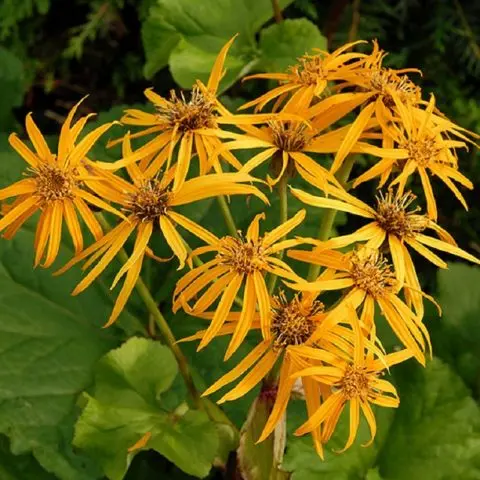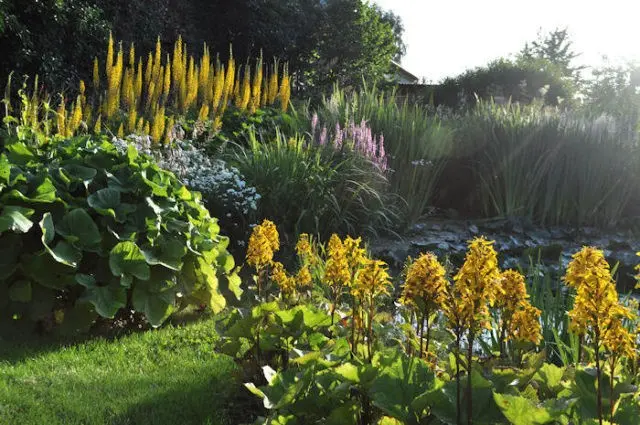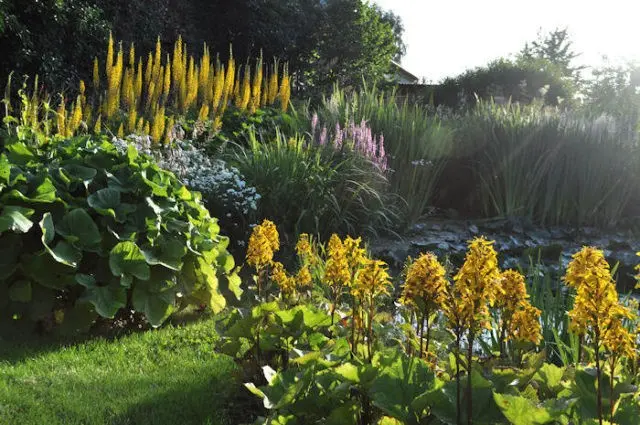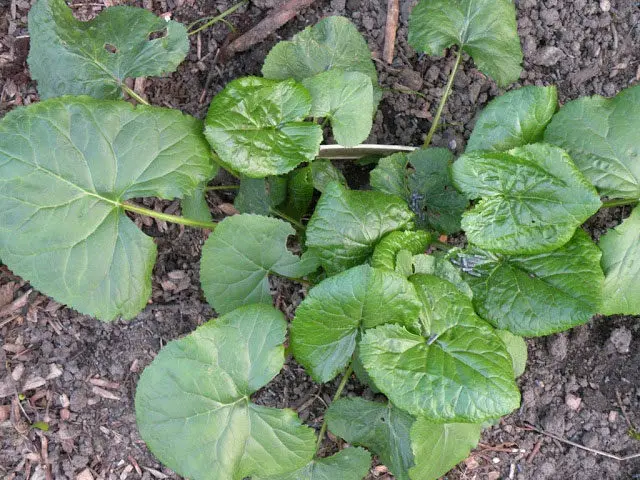Contents
Buzulnik is a perennial herbaceous plant belonging to the Asteraceae family. Its other name is ligularia. Buzulnik Hessey is a hybrid obtained by crossing two varieties – Wilson and gear. More similar to jagged, but with less dense inflorescences.

The ease of breeding, unpretentiousness and decorative appearance of the buzulnik made it one of the most popular among gardeners.
Description of buzulnik Hessey
Buzulnik has a spectacular appearance. Its magnificent yellow inflorescences blend harmoniously with the surrounding greenery, which cannot but attract the eye.
Buzulnik Hessey is a powerful tall bush with large triangular-heart-shaped leaves.
Yellow flowers are similar to daisies and are complex baskets that are collected in loose corymbose inflorescences.
Buzulnik Hessey grows up to 2 m in height and up to 1 m in width. Inflorescences reach a diameter of 5 cm.
Flowering begins in August and may continue until mid-October.

Buzulnik Hessey is characterized by lush flowering
Application in landscape design
In landscape design, both single specimens and groups are used. Plantings are especially spectacular, which include several varieties of buzulnik with different heights, shapes, and shades.
Tall plants serve as an excellent backdrop for undersized garden crops. It pairs well with many flowering species.
With the help of a buzulnik, lawns, Japanese gardens, flower beds, artificial reservoirs are decorated.

Buzulnik Hessey is well suited for creating compositions with coniferous plants
It is used to create a hedge and for zoning the site.

Buzulnik Hessey looks great on the shore of a reservoir in the company of marsh plants
It is planted in empty shaded places where other species cannot grow.
Features of reproduction
Buzulnik Hessey is propagated by seeds or by dividing the bush. Self-propagation is possible if the seeds have matured branches and hit the surface of the earth.
Seeds are collected in autumn, choosing the largest inflorescences. To do this, they are tied with a piece of cloth so that they do not crumble. When flowering ends, they are not cut. Before the onset of frost, they are removed along with the cloth, transferred to the room and laid with the cut up.
Seeds are planted directly in open ground. It is recommended to do this before winter, in November-December, using fresh, recently harvested seeds so that they undergo natural stratification.
You can sow them in open ground in the spring, deepening by 1 cm. It is necessary to ensure that the soil remains moist until emergence. When sprouts appear, they must be protected from direct sunlight from noon until evening.
Hessey buzulnik grown from seeds begins to bloom in the fourth or fifth year after planting.
Seedlings can be grown from seeds. Sowing is carried out in early spring. Seedlings are transferred to open ground in May.
Another method of reproduction is the division of the bush. In one place, the buzulnik can grow up to 20 years. But it is recommended to dig it, divide it and replant it every 5 years so that the root system does not grow much.
Planting and care
In order for Hessey’s buzulnik to develop well and please with lush greenery and color, you need to know the features of planting. It is important to take good care of it in the future.
Recommended dates
The optimal time for dividing the bush and transplanting is spring, when leaf plates have just appeared. Such delenki take root well and quickly. The division of the bush can be carried out after the end of flowering.
Planting seedlings and root shoots is best done in mid or late May, when the soil has warmed up to +10 degrees.
Site selection and soil preparation
Buzulnik Hessey does not like direct sunlight, so you need to choose shaded areas for him. He feels good near ponds in the shade of trees. The place must be protected from strong winds, as tall stems can break from strong winds.
The soil for planting should be loose and retain moisture well. Buzulnik Hessey can also grow in heavy soil, but subject to good moisture and sufficient nutrients.
The soil does not require special preparation. Before planting a buzulnik, the soil must be dug up.
Holes are dug for seedlings and delenok. When planting seeds form longitudinal furrows.
Landing algorithm
Separation of the bush and planting of plots should be carried out as follows:
- Without digging up the plant, separate the desired part from it. Cover the resulting hole with soil enriched with nutrients and water.
- Thoroughly rinse the part separated from the bush and divide it into sections using a sharp knife, each should have at least one kidney.
- Treat the cut sites with a solution of potassium permanganate or crushed charcoal.
- Dig holes measuring 0,4×0,4 m. The distance between them is 1-1,5 m. The hole should be 20 cm deeper and wider than the roots.
- Put 1,5 buckets of humus, a little wood ash and superphosphate into each hole.
- The delenka is placed in the center of the hole and covered with earth.
- Watered with water, which is preliminarily defended.
- To keep moisture longer, add mulch.
Planting seeds is as follows:
- The seed is sown randomly in longitudinal furrows to a depth of 1 cm.
- Cover with nutritious soil mixture and moisturize.
- When they germinate and reach a height of 15 cm, they are thinned out, leaving a distance of about 30 cm between them.
Watering and fertilizing schedule
If the buzulnik grows in dry soil, it must be watered daily, capturing an area around the plant equal to 1,5 m. If it is located in a wet area, next to a reservoir, watering is usually not required – there is enough rainfall.

The soil around the seedlings should always be moistened, but water should not be allowed to stagnate.
Buzulnik Hessey is fed with organic matter. Compost is applied during any growing season. Nitrogen-containing fertilizers are used in the spring to build green mass. Liquid top dressing is applied during watering.
Loosening and mulching
An adult buzulnik does not require loosening the soil, as well as removing weeds that do not grow around it. Near the seedlings, the grass is pulled out with care so as not to damage the roots located close to the surface.
Buzulnik must be mulched. The material used is a mixture of peat and compost, which is covered with straw on top. The procedure is carried out after planting, a layer is added in the autumn period, it is updated in the spring. Such a coating prevents the drying of the earth and the formation of a crust around the bush.
Preparation for winter
Buzulnik Hessey is quite resistant to frost, but at very low temperatures with a small amount of snow it can freeze. With the onset of cold weather, it is necessary to cut off the ground part of the plant, then sprinkle with mulch and cover with straw. For the winter, the buzulnik is covered with spruce branches. In the southern regions, it is left under a layer of mulch.
Diseases and pests
Buzulnik Hessey is resistant to diseases and pest attacks.
He rarely gets sick, if this happens, then it is usually powdery mildew. To combat it, gardeners spray plants with copper sulfate (10 teaspoon per 1 liters of water), potassium permanganate (1 g per 2,5 bucket of water), Fitosporin, Topaz and others.
Of the pests, slugs, which attack the plant with the advent of spring, cause particular harm. The best way to fight is to preventively cover the surface of the earth around the bush with superphosphate in granules.
Conclusion
Buzulnik Hessey – has become one of the favorites in the gardens due to its advantages. It has been growing in one place for many years, feels great in the shade, blooms for more than two months, and is undemanding in care.









